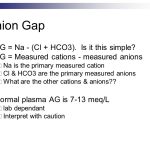When it comes to acid-base disorders, high anion gap acidosis is a condition that can cause significant distress and even life-threatening complications if left untreated. But what exactly is high anion gap acidosis, and why should you care?
Cause of High Anion Gap Acidosis: A Key Insight
In this blog post, we’ll delve into the world of acid-base physiology to uncover the underlying causes of high anion gap acidosis. Whether you’re a healthcare professional or simply someone who wants to understand their body better, this information is crucial.
What’s the Anion Gap?
The anion gap is a critical concept in acid-base physiology that measures the difference between positively charged ions (cations) and negatively charged ions (anions) in the blood. In essence, it represents the unmeasured anions – those not accounted for by the major anions like chloride and bicarbonate.
Normally, the anion gap is around 12-16 mmol/L. However, when this value exceeds 17 mmol/L, we’re dealing with a high anion gap acidosis. This condition occurs when there’s an imbalance between positively charged ions (like potassium and sodium) and negatively charged ions (like chloride, bicarbonate, and phosphate).
In the next section of this blog post, we’ll explore some of the most common causes of high anion gap acidosis. Whether it’s a metabolic disorder, a medication side effect, or something else entirely, understanding these underlying factors is essential for effective diagnosis and treatment.
To better understand the causes of high anion gap acidosis, let’s take a closer look at some of the underlying factors that contribute to this condition.
Metabolic Disorders: A Common Cause
Metabolic disorders are one of the most common causes of high anion gap acidosis. These conditions can arise from genetic or acquired mutations that disrupt normal metabolic pathways, leading to an imbalance in the body’s acid-base status.
Taking lactic acidosis as an example, this condition occurs when there’s an overproduction of lactic acid in the body, typically due to tissue hypoxia (insufficient oxygen supply). This can be caused by a range of factors, including sepsis, shock, or cardiac arrest. In these situations, the increased production of lactic acid overwhelms the body’s ability to buffer it, leading to an accumulation of unmeasured anions and a resulting increase in the anion gap.
Another example is methanol poisoning. When someone ingests methanol, their liver converts it into formic acid, which can lead to high levels of unmeasured anions in the blood, causing a high anion gap acidosis.
Medications: A Common Culprit
Medications are another common cause of high anion gap acidosis. Certain medications, such as salicylates (aspirin or its derivatives) and ethylene glycol, can disrupt the body’s acid-base balance by altering the production of unmeasured anions.
Salicylates, for instance, can lead to a high anion gap acidosis by increasing the formation of hippuric acid in the kidneys. This condition is typically seen in cases of salicylate poisoning or overdose.
Infections and Sepsis: A Serious Concern
Infections and sepsis are another common cause of high anion gap acidosis. When bacteria enter the bloodstream, they can release toxins that disrupt normal metabolic pathways, leading to an accumulation of unmeasured anions and a resulting increase in the anion gap.
This is particularly concerning in cases where patients have underlying conditions that make them more susceptible to infections, such as those with immunocompromised states or chronic illnesses like diabetes.
Other Causes
In addition to metabolic disorders, medications, and infections, there are several other causes of high anion gap acidosis. These can include:
- Ketogenic diets: A high-fat diet can lead to a buildup of ketones in the bloodstream, which can contribute to a high anion gap acidosis.
- Rhabdomyolysis: This condition occurs when muscle damage releases myoglobin into the bloodstream, leading to a high anion gap acidosis.
- Toxin ingestions: Ingesting certain toxins, such as ethylene glycol or methanol, can cause a high anion gap acidosis.
As you can see, high anion gap acidosis is a complex condition with many underlying causes. Understanding these factors is crucial for effective diagnosis and treatment.
In the next section of this blog post, we’ll explore the clinical presentation and diagnosis of high anion gap acidosis in more detail. Stay tuned!
Get Expert Consultation on High Anion Gap Acidosis
Are you concerned about the cause of high anion gap acidosis? Our medical experts are here to help.
Consult a Medical ExpertCause of High Anion Gap Acidosis: A Key Insight (Continued)
Symptoms and Causes
So, what causes high anion gap acidosis? Let’s break down some of the most common culprits:
- Metabolic disorders: Diabetic ketoacidosis, lactic acidosis, and other metabolic conditions can all contribute to a high anion gap acidosis.
- Medication side effects: Certain medications like salicylates, sulfonamides, and acetaminophen can cause a high anion gap acidosis.
- Toxic ingestions: Exposure to toxins like methanol, ethylene glycol, or isopropanol can lead to a high anion gap acidosis.
- Kidney disease: Certain kidney disorders, such as acute tubular necrosis or chronic kidney disease, can also cause a high anion gap acidosis.
These underlying causes can disrupt the delicate balance of ions in your blood, leading to a buildup of acidic substances and a decrease in bicarbonate levels. The result? A high anion gap acidosis that requires prompt medical attention to prevent life-threatening complications.
Summarizing the Key Points
So, what have we learned so far?
- The anion gap is a critical concept in acid-base physiology that measures the difference between positively charged ions (cations) and negatively charged ions (anions) in the blood.
- A high anion gap acidosis occurs when this value exceeds 17 mmol/L, indicating an imbalance between positively and negatively charged ions.
- Common causes of high anion gap acidosis include metabolic disorders, medication side effects, toxic ingestions, and kidney disease.
Final Insights
If you’re a healthcare professional, it’s crucial to recognize the signs and symptoms of high anion gap acidosis early on. Prompt treatment can mean the difference between life and death in these cases.
If you’re someone who wants to understand their body better, knowing the causes and risks associated with high anion gap acidosis can empower you to take control of your health.
A Strong Conclusion
In conclusion, high anion gap acidosis is a serious condition that requires immediate medical attention. By understanding its underlying causes and recognizing its symptoms, we can work together to prevent life-threatening complications and ensure optimal patient outcomes.
Remember: knowledge is power. Stay informed, stay vigilant, and empower yourself with the insights you need to take control of your health.
Which of the Following is Not a Function of the Liver: Do you know what your liver does? Test your knowledge with this fun quiz and learn more about the importance of liver function.
Black Beans Nutrition Fact: Are black beans a part of your healthy diet? Find out what makes them so nutritious and how you can incorporate more fiber, protein, and vitamins into your meals.




